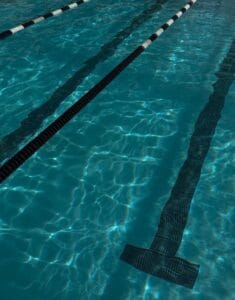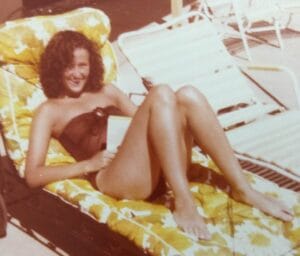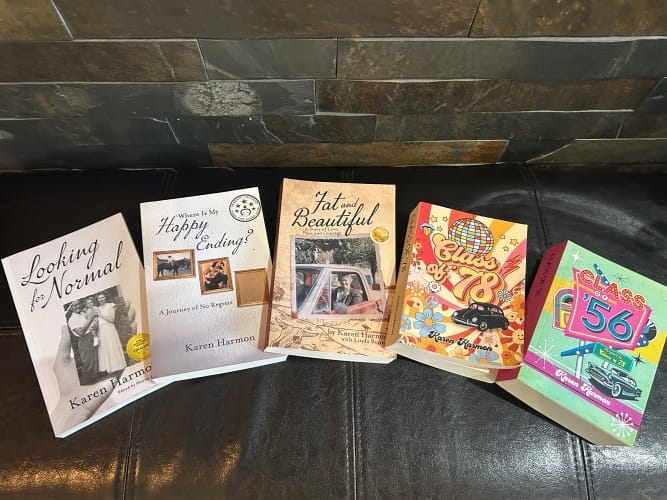Silent waters call
Sun-kissed ripples gently dance
Freedom in each stroke

As a child, from the age of five onward, waking up to the knowledge that I had swimming lessons after school was the equivalent of being told I had a dentist appointment and three fillings.
I did not like swimming lessons, and my shyness was the bane of my young existence. The nerves about doing something wrong, the fear of not knowing how to do what was asked of me, and the worry of meeting other children were my life’s trifecta of terror.
Yet, paradoxically, I loved being in the water.
When I did not want to go and begged to stay home, my mom would share her swimming woes. Her father’s sink-or-swim method—throwing her into the water—didn’t work, leaving her unable to swim and plagued by a lifelong fear that someone might toss her into the deep end. “If you do not learn to swim, you won’t get invited to pool parties,” she’d say, lamenting her social regrets and urging me to live life to the fullest.
So, as an easygoing passive child, I climbed in the smoke-filled, sickly green Chevy Impala, and with the windows rolled up and the ashtray overflowing, we would go.
My older brother’s radio stations were always tuned into 14CFUN or CKLG, so when “All You Need Is Love” by The Beatles and “A Whiter Shade of Pale” by Procol Harum played on the car radio, my stomach turned and my mind wandered to what was coming.
Driving down Grand Blvd, admiring the colourful rhododendrons, and then turning left on Keith Road, I knew we were getting close to the North Shore Winter Club. After parking in the expansive lot, I already began to shiver at the thought of cold water and endless laps consisting of the front crawl, breaststroke, backstroke, side stroke, and, years later, “lifesaving training.”
Ironically, I took swimming and figure skating lessons while my older brothers played hockey at the North Shore Winter Club. It’s ironic because we weren’t the sort of family who could typically afford the club’s luxuries—an expansive, slightly heated outdoor pool, a diving tank, lush gardens, two ice arenas, curling rinks, bridge clubs, and the best crinkle-cut french fries I had ever tasted.
Our venture into this life of luxury was courtesy of my father, who was gifted an honorary membership at the high-end country club in the late 1950s. Why? Because Vince Bonner Bulldozing cleared the land in 1956. There may be no official record of this, but regardless, our entire family enjoyed the benefits of my father’s likable personality and strong work ethic.
As a little girl, I occasionally accompanied my dad to work, and I can still vividly recall the earthy aroma of rich topsoil. I remember the deep roar of the bulldozer starting up while I sat securely on my dad’s lap, feeling the vibrations through my little girl’s frame. The land clearing for the Winter Club, located on Keith Road in North Vancouver, happened 67 years ago before I was born. Once covered in dense, forested land, the area became a vibrant community hub thanks to my dad’s hard work.
Imagine a colossal bulldozer roaring to life, its engine growling like a beast awakened. The massive steel blade gleamed under the hot sun, slicing through untamed land with relentless power. Trees that once stood as towering sentinels of the wilderness toppled like matchsticks, their roots tearing free from the moist earth with a sound like a giant’s sigh. The rich, loamy soil churned beneath the treads, releasing the earthy scent of nature’s foundation into the air. Shrubs and underbrush surrendered to the machine’s unstoppable advance, their vibrant greenery reduced to a tangled mass of crushed vegetation. Dust rose in swirling clouds, marking the path of transformation as the bulldozer carved a plot of land from the rugged landscape; the North Shore Winterclub progressed in an era of rapid change.
Steel beast moves forward
Ancient trees fall, earth reshaped
Progress carves its path
Well, I made it—I learned to swim! This newfound skill unlocked hours of fun in the sun at Ambleside Beach in West Vancouver, adventurous camping trips to Osoyoos, and the sheer joy of swimming and diving into a homemade pond my father dug with his D6 Caterpillar and Caterpillar 955 Front End Loader on our fifty acres of land in Mission, B.C. Picture this: a swimming hole stocked with rainbow trout, a diving board crafted from a tree stump and a massive raft cut from a cedar tree from the property. Young and old alike frolicking, diving and tipping the raft. Laughter and heartwarming fun. It was the epitome of rustic charm and childhood bliss.
As I grew older, my aquatic adventures expanded. I relished swimming at hotels across B.C., from the luxurious Harrison Hot Springs to the humble yet welcoming Motel 6 in Kelowna. Vacations to Hawaii and Mexico brought even more delightful experiences—poolside sunbathing, refreshing dips, and exhilarating dives into the salty embrace of the Pacific Ocean.
Swimming became a lifelong passion, and each splash reminded me of my mother’s insistence and the journey from a timid child to a water-loving beach blanket babe.
Eventually, I took my swimming prowess for granted—diving deep to retrieve shells or lazily floating on air mattresses, waiting for the next wave. I revelled in my salt-stained skin and early sun damage. The 1960s and ’70s weren’t a time for sunscreen, skin protection, or worries about what the harsh rays were doing to our bodies. We slathered on baby oil, squeezed lemon juice in our hair, and sported bikinis and puka shell necklaces. The musical strains from a transistor radio filled the air with our favourites, from the Rolling Stones and The Beatles to KC and the Sunshine Band.
Looking back, it was like we were human french fries, basking in the sun and sizzling to golden perfection, blissfully unaware of the crispy consequences.

Karen 1981
That was then – this is now…
Joints creak in silence,
Wrinkles map years on weathered skin—
Aching bones whisper.
On March 16, 2024, I began my medical leave from two jobs I adored—roles that made me feel like I had the perfect career. For 30 years, I have been an Education Assistant (EA), primarily working at high schools and for 44 years, a BCRPA Fitness Instructor. Every night, I went to bed excited for the next day. My students challenged me and brought joy, while my co-workers provided camaraderie, support, and endless fun. My work gave me purpose and made me feel happy to be alive.
Hold on, back up…
Gradually, my hip flexor muscles had stiffened over the past three years, my gluteus muscles felt like they were on fire, and my quadriceps ached deeply. I attributed this to decades of teaching fitness—wear and tear on the muscles, overuse, body fatigue, and being rundown. To manage the pain, which seemed to worsen daily, I reduced the number of fitness classes I taught and began taking Tylenol, Advil, Motrin, and Aleve—whatever concoction temporarily worked without requiring a prescription.
After my doctor referred me, I underwent physiotherapy and massage therapy and even lost a little extra weight upon her suggestion. I also had X-rays and ultrasounds, received injections, took rest, and did lots of stretching.
By the end of summer 2023, fear set in. Each day became more gruelling than the last. My once cheerful, optimistic attitude had soured, and my zest for living each day to its fullest had diminished—sleepless nights filled with leg spasms brought on anxiety about my upcoming duties for the next day. Limping through the hallways of my school job caused my self-esteem to plummet and my discouragement to rise.
I had planned to teach fitness until my last breath and work as an EA until at least 65 or longer. I always envisioned walking the Camino de Santiago in retirement with my husband. The Camino de Santiago, also known as the Way of St. James, is a network of pilgrimage routes that stretch across Europe, all leading to the shrine of the apostle Saint James the Great in the Cathedral of Santiago de Compostela in Galicia, northwestern Spain. The most popular route is the Camino Francés, which begins in St. Jean-Pied-de-Port in France and covers approximately 780 kilometres (about 500 miles) to Santiago de Compostela.
My husband is an avid walker, and my hopes and dreams of joining him on this pilgrimage were fading. The undiagnosed pain was like carrying an invisible burden that weighed me down more each day, making every step feel like a trek through quicksand. As my body struggled, so did my spirit, leaving me questioning if I’d ever live my dream of walking the Camino with him, exploring those breathtaking northern Spanish landscapes on a journey that is as spiritual as it is physical.
Mountain air whispers,
Footsteps dance on rugged trails—
Nature’s joy unveiled.
I had gotten to a point where I could hardly walk, stand, sit, or lie down without the chronic, relentless pain.
Finally, after navigating the paperwork, I applied for medical leave. Forms, appointments, signatures and faxes. On my first day off, I assumed I would feel instant relief, like taking a well-needed break. Instead, the first three weeks were marked by utter exhaustion, like I had been run over by a truck. After the immense fatigue began to lift, I became depressed, feeling like I had lost my purpose.
I couldn’t walk, stand, sit, or lie down without the chronic, relentless pain. On top of that, I missed my active lifestyle, friends, co-workers, and students. I felt lonely and alone.
I still had my writing, but I had lost the desire to conjure up creative words or put my fingers on the keyboard to type.
My thoughts spiralled downward. My body grew weaker, my muscles softened, and my shoulders hunched inward. “Why me? Is this how I am now? What am I going to do?”
Then I started swimming.
The first thing I noticed was my buoyancy—a lightness of being. My body felt free, flowing as one with the water. With every stroke, I reached, pulled, kicked and lengthened. In the water, my pain was almost non-existent. With each breath, my mind became more precise. My thoughts unravelled, and I began to feel hopeful.
I thought about my three adult children and how proud I am of them. I reflected on my abundance of dear friends, a beautiful, healthy grandson, and the yummy dinner I considered making. My imagination returned, and plots thickened as stories unfolded in my mind for my next book.
In 30 minutes of gliding through the water, I felt 16 again. Aches and pains were interrupted, age halted, and youthfulness surged. I had figured something out, but I was unsure what it was…
To my dismay, the pain returned when I got out of the water.
After realizing I had not been miraculously healed, swimming became a brief sanctuary, like rediscovering an old friend who reminds you of who you used to be. It offered a glimpse of self-discovery amidst the roped-off lanes, swirling hot tub, slippery tiles, and the nostalgic scent of chlorine.
Two and a half months into my medical leave, I went for the grand poobah of assessments—the ultimate evaluation of my chronic pain. The Lions Gate Osteo Clinic. I cried through the entire appointment. As tears welled in my eyes, I couldn’t decide if I was crying from relief, validation, or the shock of my diagnosis.
“It is obvious you need hip replacement surgery,” the incredibly kind specialist told me. As she showed me my skeletal frame on the x-rays and what looked like calcium deposits on the bathroom plumbing, I came to terms with the operation and what she said next…
“After you get your new hip, you can exercise, hike, walk and work again.”
Hip replacement surgery is a medical procedure in which a damaged or diseased hip joint is surgically removed and replaced with an artificial implant. This procedure is typically performed to relieve pain and improve mobility in patients with severe arthritis, hip fractures, or other hip joint conditions that have not responded to conservative treatments. The artificial joint, made of metal, ceramic, or plastic components, mimics the function of a natural hip joint, allowing patients to regain a greater range of motion and a better quality of life.
Are you someone who struggles with chronic pain?
For those fortunate enough not to experience chronic pain, it’s crucial to practice patience and empathy with those who do. Pain is subjective and invisible, leading to misconceptions and judgments. Just because you can’t see the pain doesn’t mean it’s not there. A compassionate approach, offering support without judgment, can make a significant difference in the lives of those suffering.
Chronic pain can be invisible, lurking beneath the surface of daily life, relentlessly draining the joy from even the simplest activities. Unlike the acute pain from an injury or surgery that eventually fades, chronic pain persists for months, sometimes years, wearing down both body and spirit. It’s an exhausting marathon that leaves sufferers feeling isolated and misunderstood.
The debilitating nature of chronic pain transforms routine tasks into monumental challenges. Walking, sitting, or even lying down can become torturous. Sleep is often elusive, with constant fatigue exacerbating the pain. Once clear and focused, the mind becomes foggy and distracted, making concentration and memory difficult. The emotional toll is severe, with frustration, helplessness, and depression frequently accompanying the physical agony.
It will take 6 to 12 months to meet with my surgeon and another 6 to 12 months for my hip replacement surgery. As I type this, my left leg is spasming, and a dull ache radiates through my thigh. I’m not sharing this to make you feel bad or to gain sympathy—I’m not even sure why I’m sharing it. Maybe some of you can relate, whether you’re suffering like me or have been through it and are now on the other side.
Regardless of my pain, I still have joy in my heart.
I will fill my waiting time with possibilities and plans for a healthier me. Though my days will still be painful, I hold onto hope. I look forward to returning to work, teaching fitness, visiting with my grandson, bike rides with friends, and even walking the Camino de Santiago someday.
In the meantime, I will swim daily, follow my stretch, core, and upper body weight routine, and immerse myself in writing. Missing my school and fitness jobs is a given, but I am determined to stay positive and productive. And if there are days when I can’t, please send your movie and show recommendations my way. There’s nothing like a little binge-watching once in a while.
Understanding that chronic pain sufferers are often doing their best to make it through the day can foster a more inclusive and supportive environment. Simple acts of kindness and patience—like listening without offering unsolicited advice, acknowledging their struggle, or accommodating their needs—can provide much-needed comfort and validation. With empathy and support from others, those who suffer from chronic pain do not have to feel so alone.
Now, fifty-some-odd years after taking my first swimming lesson, I look to the heavens and say, “Thank you, Mother!”
Even when I begged not to go, I’m grateful you made me. I can still see you reading your book while I swam my laps, and I vividly remember the salty crunchiness of the crinkle fries from the concession stand—even when we could not afford them.
Pain fades, dawn’s embrace,
Healing whispers, hope ignites,
New day, aches erased.
I would love to hear from you if you found my blog relatable. Please let me know if you have any movies or episodic series to recommend. You can message me here or email me at [email protected]. You can also check out my website, https://karenharmonauthor.com/, for information on other blogs, books, or speaking engagements.

2017 Karen – Singapore


What a journey it’s been for you these last number of years! You have shown a lot of courage as you’ve endured chronic pain! So happy you have hope for new horizons!
Thank you Janine, somebody sure got it right when they said life’s a journey. I do feel very hopeful about the furure. xo
Sorry to hear of your pain and suffering you are going through with your hip. Your Mom would be happy and proud that the swimming lessons she put you in as a child are now being used as your therapy for releasing some pain in your hip while you swim.
Keep dreaming of the day you and your husband walk the pilgrimage routes of Camino de Santiago!
Thank you for reading my blog Lee-Ann. I really did enjoy writing it. It was very therapeutic. And I always love looking back and remembering the past.❤️
Your blog post on swimming lessons and managing chronic pain is truly inspiring, Karen. It’s heartening to see how you transform your challenges into therapeutic experiences. Your journey and resilience offer hope to many dealing with similar struggles. Keep sharing your story and dreaming of new horizons! 🌟
Thanks so much 🏊♀️💪🏻